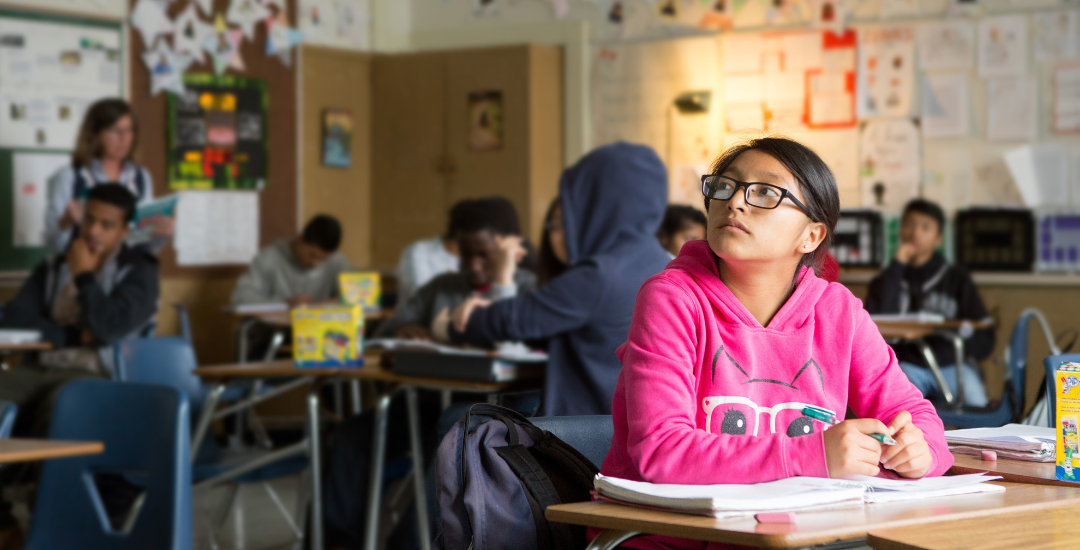While these tools and practices are crucial, they have not closed achievement gaps because we have not properly addressed spending gaps — the difference between actual and adequate per-pupil spending. Closing achievement gaps begins with closing local spending gaps because implementing our best tools and practices requires much more school funding as well as a very different distribution of resources.
Since the vast majority of school funding comes from state and local sources, and federal funding is decreasing, here I describe two important patterns in per-pupil spending in Harris County school districts and how addressing them may help close achievement gaps.
First, Harris County school districts with a higher proportion of minority students tend to have larger spending gaps.
The amount of per-pupil funding needed varies significantly from school district to school district. The School Finance Indicators Database reports what is considered adequate per-pupil spending, or the amount needed for students to perform at national average. These estimates are based primarily on each district’s local labor costs, which make up the largest portion of expenditures, and their student composition, since some students cost more to educate, such as poor students, special needs students and English learners. According to the latest estimates released in January, 91% of students in Texas are in underfunded school districts. In Harris County, all but one district is underfunded.
In addition to widespread underfunding, school districts with a higher proportion of minority students tend to have larger spending gaps. The table below lists all the school districts in Harris County, arranged by percentage of white students — from Aldine ISD, which is only 2% white, to Huffman ISD, which is 72% white. For each district, the table lists actual per-pupil spending in 2022 and adequate per-pupil spending, followed by the difference between the two, both as a dollar amount and as a percentage. For example, Aldine ISD spent $10,096 per pupil in 2022. In order for its students to perform at national average, it needed to have spent more than twice that amount — $21,692 per pupil. The spending gap was $11,596 per pupil, or 53.5% less than what was needed for average performance.
Although almost all districts’ per-pupil spending is below adequate, as seen by their negative spending gaps, per-pupil spending is closer to adequate as the percentage of white students increases. There are a few exceptions, but the overall pattern is clear: Districts whose percentage of white students is in the single digits have the largest spending gaps (from Aldine ISD at 2% to Houston ISD at 9%), ranging from 40.8% to 53.5% below adequate. These districts spent about half of what they needed to achieve average performance.
Second, school districts whose spending gaps exceed 40% tend to have lower TEA ratings.
The last column of the table shows TEA’s 2022 accountability ratings for overall student achievement, which are equivalent to letter grades (90 or above is an A, 80-89 is a B, 70-79 is a C, 60-69 is a D and below 60 is an F). With only one exception, when school district per-pupil spending is more than 40% below adequate, TEA ratings are Cs and Ds. Aldine, Alief, Pasadena, Sheldon, Channelview, Spring and Houston ISD all have C and D achievement ratings, and all of them have spending gaps that exceed 40%. In contrast, when spending gaps are less than 40% below adequate, TEA ratings are consistently As and Bs, without exceptions. The percentage of white students is strongly associated with spending gaps, which are strongly associated with student achievement ratings.
Finally, investing in reducing spending gaps will yield significant returns for everyone.
In order to help high minority districts achieve national average scores — a modest goal — we need to increase per-pupil spending so that there are no districts with spending gaps that exceed 40%. For some, this task raises two concerns: it requires too many tax dollars, and we need to know how the funds will be used. These are valid concerns, but they are not insurmountable and should not prevent us from closing spending gaps.
The concern that closing spending gaps requires too many tax dollars needs to be reframed — that is, not closing spending gaps will require even more tax dollars. As mentioned earlier, achievement gaps cost the U.S. economy trillions of dollars each year by significantly reducing our workforce, earnings, tax revenue and GDP. In addition, closing achievement gaps affects not only current but also subsequent generations, so there is a multiplier effect that makes the returns on this investment astronomical.
Another reframing is that while spending, say, $20,342 per pupil at HISD (the amount considered adequate) may seem too high, Texas spends $22,751 per inmate, and the rate of growth for prison spending — which some would argue yields much smaller returns — has far outpaced school spending. There are, of course, many more pupils than inmates, so the total amounts are quite different. However, 67% of Kinder Houston Area Survey respondents in 2022 agreed that significantly more money will be needed in order to provide a quality education. Even just bringing the largest spending gaps to under 40% would go a long way. For example, increasing HISD’s per-pupil spending by $2,059, thereby shrinking the spending gap to $8,000 or 39.3% below adequate, would increase HISD’s chances of getting an A or B achievement rating.

The concern about how the funds will be used also needs to be reframed, because we first have to ensure that there are sufficient funds available. Money in and of itself is not the solution, but lack of funds certainly precludes closing achievement gaps. With adequate (or at least closer to adequate) funding in place, we can implement and expand effective research-based practices such as full-day pre-kindergarten, one-on-one tutoring, high-quality English Learner education, middle/high school college advising and wraparound services. Without proper financial support, even the best evidence-based practices will fail.
Almost all school districts in Harris County are underfunded, and those with higher percentages of Black and Hispanic students are severely underfunded, needing about twice as much per pupil as is currently being spent. In order to help Black and Hispanic students achieve average scores — which is a modest goal — we must ask our state legislators to increase per-pupil spending significantly, especially in high minority school districts whose spending is more than 40% below adequate, perhaps starting with revisiting and updating the Cost of Education Index (CEI) stemming from a 1984 special session.
In sum, per-pupil spending in Harris County not only needs to increase significantly, it also needs to be distributed more equitably, giving districts with greater needs the funding they need. Closing these spending gaps will open the door to closing costly achievement gaps that have plagued us for far too long.




